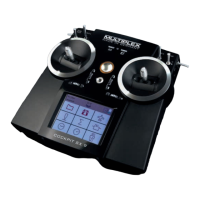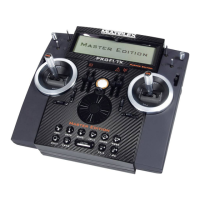ROYAL SX
24
If you have encountered problems on a previous
flight.
Important:
Always ask a second person to help you with your
range check, so that one of you can secure and ob-
serve the model.
If possible, carry out the range check when no other
trans-mitters are operating.
Preparations, carrying out the range check:
5. Select “Range check” mode on the transmitter:
Hold button F on the transmitter pressed
in.
Switch the transmitter ON.
Release button F:
The red LED on the transmitter now glows
constantly, and the message “RANGE!”
flashes on the transmitter’s screen in all
the status displays with the exception of
status display 4.
6. Switch the M-LINK receiver ON.
7. Carry out the range check as described in the op-
erating instructions supplied with your M-LINK re-
ceiver.
8. When the range check is completed, switch the
M-LINK transmitter OFF, and then ON again, in
order to switch back to full range.
! Caution: selecting “Range check” mode re-
duces the transmitter’s output power. The trans-
mitter emits an audible signal every ten seconds
or so to warn you of this. Never attempt to fly a
model with the transmitter set to reduced output
(Range check mode)!
10.7. Fast Response ON/OFF
In Fast Response mode, which operates at the ultra-
rapid pulse rate of 14 ms, up to twelve servo channels
are available. This reduced pulse rate can cause ana-
logue servos to oscillate or run jerkily.
If this occurs, or if you need to use the maximum of
sixteen servo channels, it is possible to switch Fast
Response mode OFF on the ROYALevo, ROYAL SX
or ROYAL SX M-LINK transmitter. The pulse rate is
then 21 ms.
Please refer to the notes in the operating instructions
supplied with your ROYAL SX M-LINK transmitter in
this regard.
This is the procedure for switching Fast Response ON
or OFF if you are using a ROYALevo, ROYAL SX or
ROYAL SX M-LINK transmitter:
1. Switch the transmitter ON.
2. Press button I on the transmitter.
3. Mark the menu point Modulation by rotating one
of the
3-D digi-adjusters, or by pressing the button.
4. Press the ENTER button, or one of the 3-D digi-
adjusters.
5. Mark the menu point FastResponse by rotating
one of the
3-D digi-adjusters, or by pressing the button.
6. Press the ENTER button or one of the 3-D digi-
adjusters.
7. Select one of the options ON or OFF by turning one
of the
3-D digi-adjusters, or by pressing the or but-
tons.
8. Confirm your selection by pressing the ENTER
button, or by pressing one of the two 3-D digi-
adjusters.
9. Quit the menu.
! Note:
If you enable or disable Fast Response mode, you
must repeat the binding process between trans-
mitter and receiver ( 9.)!
10.8. The Status displays
“Status display” is the term we use for the four differ-
ent screen displays which appear as options when the
transmitter is “started” (with or without RF trans-
mission).
You can switch between the individual Status displays
using the “” or “” buttons.
10.8.1. Status display 1 (standard)
Status of the 3-D digi-adjusters.
Numerous set-up parameters can be allocated to
the 3-D digi-adjusters, which can then be adjusted
while the model is flying ( 20.1.)
Current model memory with memory number and
model name: 5:GLIDER
Actual operating voltage of the transmitter battery in
numeric form and as a graphic bar display
Transmitter type: ROYAL SX 9 or 16
Operating time for the currently active model mem-
ory ( 18.2.)
The four bars at the sides and bottom indicate the
current trim positions for the four primary control
functions / sticks
10.8.2. Status display 2 (flight phases)

